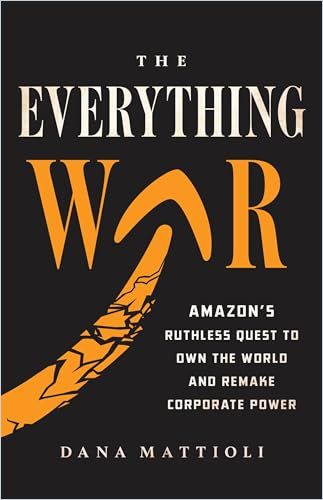Wall Street Journal senior reporter Dana Mattioli describes how Amazon’s use of suppliers’ sales data led to accusations of monopolistic practices.

Data Matters Most
Wall Street Journal senior reporter Dana Mattioli describes Amazon’s rise and covers the reasons behind accusations that it engages in monopolistic practices. Critics cite such practices as hampering third-party sales on its website and using suppliers’ sales data for its own purposes. Those charges are the subject of ongoing litigation.
A “culture of metrics”
In 1994, Jeff Bezos quit a comfortable job at a New York City hedge fund to start Amazon, a pioneering, internet-based bookselling business that quickly expanded. By 1998, Amazon stock’s market cap exceeded the combined market value of its book-retailing rivals, including Barnes & Noble.
Everyone would come to need it for their own purposes. Avoiding Amazon, in a way, became impossible.Dana Mattioli
At a company retreat in 1997, Bezos declared that Amazon needed a “culture of metrics” to focus its employees’ attention on ways to make use of its vast trove of consumer data. It soon developed additional assets, including technological know-how.
In 2000, Amazon began to allow other retailers and independent sellers to market their products through its website’s Amazon Marketplace. This created competing internal retail groups: first-party operations managed by Amazon employees selling Amazon’s inventory versus third-party operations which brought external sellers and buyers together on Amazon’s platform.
In 2003, Amazon began selling another internal asset: its expertise in technological infrastructure developed through its work in online sales, order processing, and delivery operations. In 2007, Amazon entered the personal device business with the Kindle electronic reader. And, by 2021, Amazon’s Web Services (AWS) unit, which helped inaugurate cloud computing, accounted for nearly 75% of its corporate profits.
Amazon’s private label vs. its third-party vendors
In 2009, Amazon began manufacturing and selling private-label versions of popular products. It branded its products under the label Amazon Basics. HDMI cables became the first Amazon Basics product to sell more than one million units. Amazon did not allow employees of its private-label products to use data from its Marketplace third-party sellers.
In 2012, Leor Grebler, the co-founder of Ubi, invented a pioneering voice-activated device and pursued a partnership with Amazon. In 2014, Amazon released Echo, its own voice-activated device. After Echo’s launch, Ubi became the first of many companies to accuse Amazon of funneling information gained from its business relationships and negotiations into its private product development.
Data was king at Amazon. It was the measure of any Amazonian’s ability to play God in their sector [of the economy].Dana Mattioli
In 2014, Amazon also introduced the Fire TV set-up box, used for streaming movies and TV programs, and the Alexa smart speaker, an assistant with voice-command activation. The next year, it started the Alexa Voice Service, which authorized other companies to sell Alexa-compatible devices. In that process, Amazon garnered data about its competitors’ technologies and their customers’ homes. Amazon didn’t charge a fee to companies that made Alexa-compatible devices – their users’ data was its real payment.
Questionable Tactics
Amazon sometimes prohibits companies among its top third-party sellers from buying internal ads (that is, from Amazon) to improve their visibility in its website’s search results, thus dampening their ability to compete with Amazon’s internal products. For example, Fire TV’s fiercest competitor is Roku, which sells its streaming media player on Amazon. Amazon forbade Roku from buying onsite search keywords that link to Fire TV. Then, it additionally prevented Roku from buying placement for its own keywords on Amazon’s website. That would have put Roku at the top of the category’s search results.
Andy Dunn co-founded Bonobos, an online men’s clothing business. Its most popular product was khaki pants, priced at almost $100. Dunn met with Amazon to discuss its acquiring Bonobos. Amazon never bought Bonobos, but it subsequently began selling its own private-label khaki pants priced at less than $25.
As it grew, Amazon opened warehouses and hired workers in low-sales tax, lightly populated US states to minimize its sales tax collections. It benefited from a 1992 US Supreme Court decision saying that online retailers had to charge sales tax only in jurisdictions where they have physical stores or other staffed operations. Amazon designated its warehouses as “subsidiaries,” not “operations,” to avoid collecting sales tax in multiple states. In 2008, Amazon collected sales tax in only four states. Now, however, the company collects sales tax in every state that assesses one.
Federal Trade Commission Lawsuit
When the entrepreneurial segment of the US retail industry faltered in the early 2000s, experts saw Amazon’s growth as having a significant impact. From 2007 to 2017, 65,000 United States small retail businesses disappeared. By 2023, retailers selling goods on Amazon paid fees to it that equaled 45% of their sales revenue. These fees, including sales commissions, advertising costs, and shipping, forced retailers to charge higher prices.
Amazon had already eliminated lots of retail competition over the years, but the pandemic cemented it as a de facto retailer of choice.Dana Mattioli
The Wall Street Journal reported in 2009 that federal regulators had banned or declared unsafe thousands of Amazon Marketplace products. Amazon asserted that it has no liability for products listed by third-party sellers, although they account for 60% of its sales.
A lawsuit filed by the Federal Trade Commission and 18 state attorneys general on September 26, 2023, accused Amazon of monopolistic practices. The FTC charged that Amazon had inflated prices across retail websites by penalizing third-party sellers for charging lower prices on its competitors’ websites. As Amazon raised third-party sellers’ fees, the sellers raised their prices to offset the cost.
The FTC cited “structural relief” – such as divestiture or breaking up the company – as a possible remedy. The lawsuit is currently in the courts and may take years to resolve.
Amazon As Data Vampire
Experienced Wall Street Journal reporter Dana Mattioli frames his portrait of big business in multiple contexts: chronological, social, legal, financial, and political. (The book pre-dates the second Trump administration, which may take a different approach to big tech corporations.) One thread runs through his book and illuminates every transaction: with each new technological development, Amazon developed more ways to drain revenue from retailers or to exploit its technology for its own ends or both. Mattioli paints a shocking but seemingly inevitable portrait of a company that remains at the forefront because its competitors provide it with 21st-century gold: data. He explains the engineering behind Amazon’s approach with clarity, sometimes humor, and more than a suggestion of moral outrage.









